The enthusiasm in the Mar. 20, 2013 news release on EurekAlert about Darren Sun’s work with titanium dioxide nanofibres seems boundless,
A new wonder material that can generate hydrogen, produce clean water and even create energy.
Science fiction? Hardly, and there’s more – It can also desalinate water, be used as flexible water filtration membranes, help recover energy from desalination waste brine, be made into flexible solar cells and can also double the lifespan of lithium ion batteries. With its superior bacteria-killing capabilities, it can also be used to develop a new type of antibacterial bandage.
Scientists at Nanyang Technological University (NTU) in Singapore, led by Associate Professor Darren Sun have succeeded in developing a single, revolutionary nanomaterial that can do all the above and at very low cost compared to existing technology.
The Nanyang Technological University Mar. 20, 2013 news release (also posted to EurekAlert) gives details about how Sun created his ‘wonder’ material,
This breakthrough which has taken Prof Sun five years to develop is dubbed the Multi-use Titanium Dioxide (TiO2). It is formed by turning titanium dioxide crystals into patented nanofibres, which can then be easily fabricated into patented flexible filter membranes which include a combination of carbon, copper, zinc or tin, depending on the specific end product needed.
Titanium dioxide is a cheap and abundant material, which has been scientifically proven to have the ability to accelerate a chemical reaction (photocatalytic) and is also able to bond easily with water (hydrophilic).
…
Prof Sun, 52, from NTU’s School of Civil and Environmental Engineering, said such a low-cost and easily produced nanomaterial is expected to have immense potential to help tackle ongoing global challenges in energy and environmental issues.
With the world’s population expected to hit 8.3 billion by 2030, there will be a massive increase in the global demand for energy and food by 50 per cent and 30 per cent for drinking water (Population Institute report, titled 2030: The “Perfect Storm” Scenario).
“While there is no single silver bullet to solving two of the world’s biggest challenges: cheap renewable energy and an abundant supply of clean water; our single multi-use membrane comes close, with its titanium dioxide nanoparticles being a key catalyst in discovering such solutions,” Prof Sun said. “With our unique nanomaterial, we hope to be able to help convert today’s waste into tomorrow’s resources, such as clean water and energy.”
…
Prof Sun had initially used titanium dioxide with iron oxide to make anti-bacterial water filtration membranes to solve biofouling – bacterial growth which clogs up the pores of membranes, obstructing water flow.
While developing the membrane, Prof Sun’s team also discovered that it could act as a photocatalyst, turning wastewater into hydrogen and oxygen under sunlight while still producing clean water. Such a water-splitting effect is usually caused by Platinum, a precious metal that is both expensive and rare.
Here’s a list of what the researchers are claiming multi-use titanium dioxide materials can accomplish, from the news release,
Producing hydrogen and clean water
This discovery, which was published recently in the academic journal, Water Research, showed that a small amount of nanomaterial (0.5 grams of titanium dioxide nanofibres treated with copper oxide), can generate 1.53 millilitre of hydrogen in an hour when immersed in one litre of wastewater. This amount of hydrogen produced is three times more than when Platinum is used in the same situation.
Depending on the type of wastewater, the amount of hydrogen generated can be as much as 200 millilitres in an hour. Also to increase hydrogen production, more nanomaterial can be used in larger amounts of wastewater.
Producing low-cost flexible forward osmosis membranes
Not only can titanium dioxide particles help split water, it can also make water filter membranes hydrophilic – allowing water to flow through it easily, while rejecting foreign contaminants, including those of salt, making it perfect for desalinating water using forward osmosis. Thus a new super high flux (flow rate) forward osmosis membrane is developed.
This discovery was published recently in last month’s journal of Energy and Environmental Science. This is the first such report of TiO2 nanofibres and particles used in forward osmosis membrane system for clean water production and energy generation.
Producing new antibacterial bandages
With its anti-microbial properties and low cost, the membrane can also be used to make breathable anti-bacterial bandages, which would not only prevent infections and tackle infection at open wounds, but also promote healing by allowing oxygen to permeate through the plaster.
The membrane’s material properties are also similar to polymers used to make plastic bandages currently sold on the market.
Producing low-cost flexible solar cells
Prof Sun’s research projects have shown out that when treated with other materials or made into another form such as crystals, titanium dioxide can have other uses, such as in solar cells.
By making a black titanium dioxide polycrystalline sheet, Prof Sun’s team was able to make a flexible solar-cell which can generate electricity from the sun’s rays.
Producing longer lasting lithium ion batteries
Concurrently, Prof Sun has another team working on developing the black titanium dioxide nanomaterial to be used in Lithium ion batteries commonly used in electronic devices.
Preliminary results from thin coin-like lithium ion batteries, have shown that when titanium dioxide sphere-like nanoparticles modified with carbon are used as the anode (negative pole), it can double the capacity of the battery. This gives such batteries a much longer lifespan before it is fully drained. The results were featured prominently in a highly respected Journal of Materials Chemistry on its cover page last year.
As is expected these days, from the news release,
Next step – commercialisation
Prof Sun and his team of 20, which includes 6 undergraduates, 10 PhD students and 4 researchers, are now working to further develop the material while concurrently spinning off a start-up company to commercialise the product.
They are also looking to collaborate with commercial partners to speed up the commercialisation process.
Here’s a citation and a link for the paper,
Novel-Structured Electrospun TiO2/CuO Composite Nanofibers for High Efficient Photocatalytic Cogeneration of Clean Water and Energy from Dye Wastewater by Siew Siang Lee, Hongwei Bai Zhaoyang Liu, & Darren Delai Sun. Water Research Available online 19 March 2013 In Press, Accepted Manuscript http://dx.doi.org/10.1016/j.watres.2012.12.044
This paper is behind a paywall. Good luck to Professor Sun and his colleagues.


![Chip containing U.S. and Israeli Declarations of Independence, on Jerusalem stone (downloaded from http://www.ats.org/site/News2?page=NewsArticle&id=7807&news_iv_ctrl=1161]](http://www.frogheart.ca/wp-content/uploads/2013/03/TechnionDeclOfIndep-1024x683.jpg)